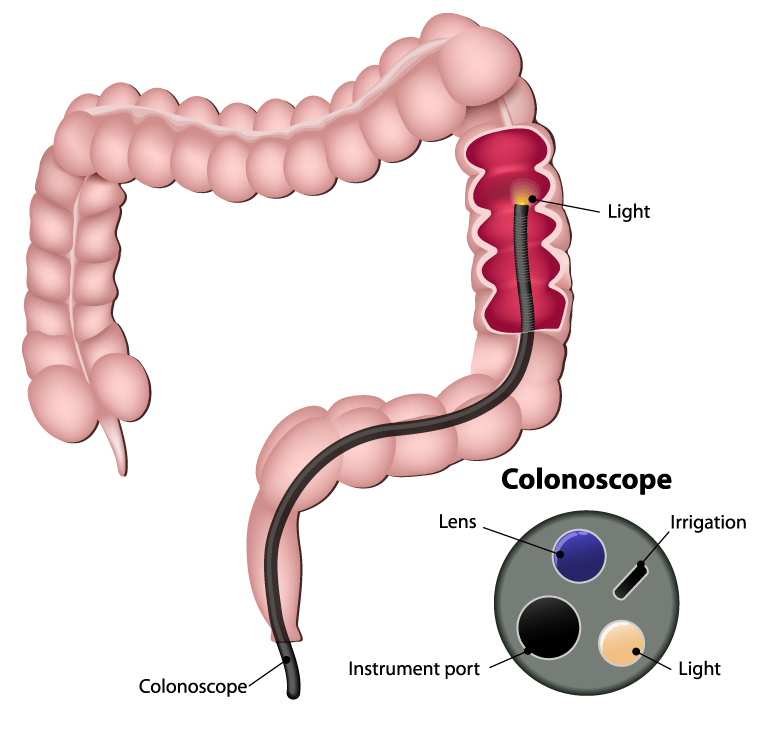Having a flexible sigmoidoscopy
Your family doctor and/or hospital specialist has arranged for you to have this examination as this is the best way to investigate your bowel (colon) problems.
The benefits of this examination include the ability to take pictures and samples (biopsies) to analyse parts of the large bowel lining which may be abnormal.
What is a sigmoidoscopy?
A sigmoidoscopy is a test that allows the endoscopist to look directly at the lining of the left hand side of the large bowel. In order to perform the test a colonoscopy is carefully passed through the anus into the large bowel. The colonoscopy is a long flexible tube, about the thickness of your index finger, with a bright light at the end. The tube gives the endoscopist a clear view of the lining of the bowel and can check whether any disease is present. Sometimes the endoscopist may take a small tissue sample (biopsy) using tiny forceps for examination in the laboratory.
It is also possible to remove polyps during the sigmoidoscopy using a wire loop. Polyps are small growths of extra tissue on the bowel wall, which the doctor may want to examine in more detail by sending them to the laboratory for analysis.
What should you expect?
The preparation:
To allow a clear view, the bowel needs to be empty. If it is not, the endoscopist will not be able to see the bowel walls clearly and the test may be inconclusive, and then have to be repeated. Bowel preparation can be given in two ways:
Oral bowel preparation
You will receive information about this with your appointment. It is important to take the entire laxative prescribed. It is also important that you follow the instructions clearly when you are taking the laxative as this will provide us with the best views of your bowel possible.
OR
Enema bowel preparation
You may be given an enema in the department, which will ensure you have a bowel movement, to allow the test to take place. You can eat normally up until six hours and drink clear fluids up to two hours before your procedure time.
Please avoid seeded bread, tomatoes and jelly for one week prior to your examination, as seeds and skins can often be seen during your test, and have the potential to block the equipment.
Admission:
When you arrive, please book in to the endoscopy reception area. Your appointment time given is the beginning of your time in the department. Please be prepared to be in the department all morning or afternoon as delays can occur.
A nurse will explain the examination to you. If you have any concerns or questions at this stage, do not be afraid to ask.
The nurse will ask about your medical history; please tell us if you have had any allergic or bad reactions to medications or other tests. Your consent for the procedure may be obtained at this stage by the nurse. If not, the Endoscopist will meet you and explain the examination to you prior to the procedure.
You will be given a pair of privacy shorts to change into instead of your normal underwear (you are able to remain fully clothed until the procedure). A private changing area will be available.
During the test:
On occasions the person carrying out your test will be a trainee working under the supervision of a fully qualified endoscopist. In the examination room you will be made comfortable on a hospital trolley, resting on your left side, with your knees bent up towards your tummy. A nurse will stay with you throughout the examination, which usually takes between 10 and 20 minutes . The shape of the bowel varies from person to person and for some it may take longer. If samples of tissue are taken or a polyp removed, again this can prolong the examination.
The nurse will put a clip on your ear or finger, in order to monitor your pulse rate and oxygen saturation during the examination. When the camera has been gently inserted through the anus in to the large bowel, air will be passed through to open the bowel walls, which gives a clear view of the lining. If you experience the sensation of wanting to go to the toilet, please do not worry. The bowel is empty and there is no danger of this happening. The air and stretching of the bowel walls may also give you a bloating or cramping feeling in your abdomen. Various options to relieve this discomfort are available.
Pain relief:
Pain relief is not normally required for a sigmoidoscopy, however if you experience discomfort either Entonox or sedation can be used.
Entonox: often called ‘gas and air,’ this provides pain relief when inhaled through a mouthpiece. It means that you have control over how much or how little you take. One of the advantages of Entonox is that it quickly leaves the body. You will be able to drive 30 minutes after the procedure and return to normal daily activities.
OR
Sedation: is given by the endoscopist through a small needle placed in a vein; a painkiller is also given at this time. Sedation is not a general anaesthetic, but will make you more relaxed. Having sedation involves some restrictions, and it is essential that someone collects you from the unit and stays with you for 24 hours. Once home it is important to rest for the remainder of the day. The effects of sedation can last up to 24 hours therefore you must not: drive a car or motorbike, operate machinery, drink alcohol, make any important decisions or be alone.
Recovery and Discharge:
Following the procedure, you will be taken to the recovery room to rest.
As you recover, you will be advised to release any ‘wind’ that may be trapped in your large bowel. We do appreciate that this can be embarrassing but it is important you do ‘let it go’.
Results:
Your nurse and/or the endoscopist will explain the results to you. The test results will be written down and information leaflets provided if necessary.
If a biopsy has been taken or polyp removed, these results can take up to 6 weeks to process. The results will be sent to your GP and/or specialist who referred you for the procedure.
You may wish to have your next of kin present when the results of your examination are discussed.
Can there be any side effects or complications from having a sigmoidoscopy?
For most people a sigmoidoscopy is a straightforward procedure, but in rare cases there may be complications. These can include the following:
- Recurrent colicky type pains may occur. These should gradually ease off over 24 hours.
- Heavy bleeding that needs further investigation or medical advice. Polyps above 1 cm in size that are removed during a sigmoidoscopy may cause heavy bleeding requiring a blood transfusion. It is estimated that this could happen in around every 1 in 100 polypectomies.
- The colonoscope can cause a hole (perforation) in the wall of your bowel. The chances of this happening are 1 in 5,000. The risk of perforation increases if polyps are removed to 1 in 2,500. If this happens, you may need an operation to repair it.
- There is also a small chance you may have a reaction to the drugs used for the procedure. Serious problems are rare as you are carefully monitored during the investigation.
Are there any alternatives?
A CT Cologram can be undertaken as an alternative. This is a special CT scan done in the X-Ray department and can show if there are any abnormalities of the bowel. However, this does not allow tissue samples to be taken.
Trainees:
On some occasions, the person carrying out your test will be a trainee working under the supervision of a fully qualified endoscopist. If you are not comfortable with this please highlight this to the nurse on admission.
Checklist:
- Please let us know if you cannot attend your appointment, so we can allocate it to someone else.
- Take bowel preparation as directed and follow all instructions regarding eating. Please drink plenty of fluids.
- Bring an up to date list of medications.
- Please contact us if you take Warfarin, Clopidogrel, Rivaroxaban, Dabigatran, Apixaban or any other blood thinning tablets.
- If you take insulin or tablets for your diabetes you should contact your practice/diabetic nurse for advice before taking the bowel preparation.
- Write down any concerns/questions.
- If you need information in your own language or an interpreter, including sign language, please contact the endoscopy unit.
- Ensure one finger is free of nail polish or false nails.
- If you are having sedation make sure that you have someone to collect you in a car/taxi and to stay with you for 24 hours following the procedure.
Contact Details
- Furness General Hospital: telephone 01229 491112
- Westmorland General Hospital: telephone 01539 715175/715187
- Royal Lancaster Infirmary: telephone 01524 583724
Opening Times: Monday – Friday 9am - 6pm


